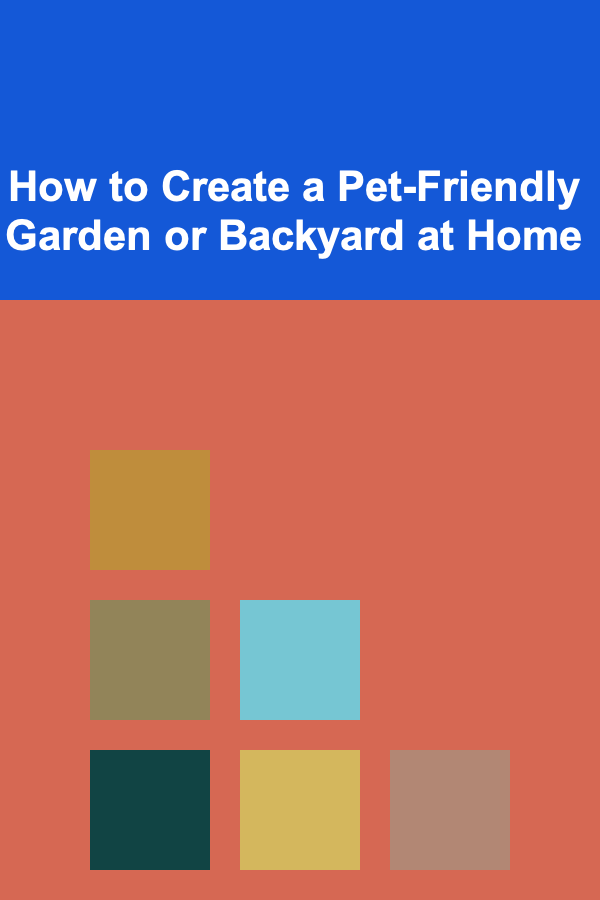
How to Create a Pet-Friendly Garden or Backyard at Home
ebook include PDF & Audio bundle (Micro Guide)
$12.99$8.99
Limited Time Offer! Order within the next:

Creating a pet-friendly garden or backyard at home is an excellent way to ensure your pets have a safe, stimulating, and enjoyable environment to play in. Whether you have dogs, cats, or other pets, a garden or backyard can serve as an oasis where they can engage in physical activity, explore nature, and unwind. Designing such a space requires careful planning and consideration of your pet's needs, safety, and enjoyment. In this guide, we will explore how to create a pet-friendly garden that meets these criteria and enhances both your pet's and your family's quality of life.
Understand Your Pet's Needs
Before you start planning the layout of your pet-friendly garden, it's essential to understand your pet's specific needs and behaviors. Each type of pet has unique characteristics, so creating a suitable environment requires taking these into account.
Dogs
Dogs are typically energetic animals that love space to run around and play. They also need mental stimulation to keep them engaged. If you have a dog, your garden should include areas where they can run freely, explore, and be stimulated by scents and sounds. Dogs also love digging, so it's important to create areas where they are allowed to dig without damaging your plants.
Cats
Cats, on the other hand, tend to be more independent but still enjoy outdoor time. They may prefer shaded areas for lounging, climbing spaces, and access to hideaways where they can rest peacefully. Unlike dogs, cats may not need as much open space for running but will benefit from vertical spaces like cat trees or shelving to climb and perch.
Other Pets (Rabbits, Guinea Pigs, etc.)
If you have smaller pets like rabbits or guinea pigs, they will need secure enclosures where they can graze on grass and nibble on plants. These pets also benefit from having hiding places where they can retreat and feel safe. An enclosed pen or an outdoor cage might be ideal for smaller animals to ensure their safety.
General Considerations
It's important to consider factors like the pet's age, size, energy levels, and whether they have any health conditions. Senior pets, for example, might need softer ground, low-height obstacles, and shaded areas to avoid overexertion. Additionally, animals with limited mobility or physical challenges might require ramps, raised platforms, or gentle paths for easier movement.
Safe and Non-Toxic Plants
One of the most significant aspects of creating a pet-friendly garden is selecting safe plants. Many common garden plants are toxic to pets, especially cats and dogs. For example, lilies, azaleas, and certain types of ivy can cause digestive issues, heart problems, or even death in pets if ingested.
Research Safe Plants
When planning your garden, opt for plants that are non-toxic to pets. Some safe plants include:
- Catnip: Cats love catnip, which also has a calming effect.
- Lavender: Lavender is safe for both cats and dogs and can have a calming scent.
- Spider Plants: These are non-toxic to both cats and dogs and can be placed in hanging baskets.
- Sunflowers: These are vibrant, dog-friendly flowers that are safe for pets and thrive in sunny spots.
- Marigolds: These are safe for both dogs and cats and are easy to maintain.
- Snapdragons: These are safe and add beauty to your garden.
- Pet-safe grass varieties: Look for grass types like fescue or ryegrass, which are safer than others that may cause irritation.
Toxic Plants to Avoid
There are several common garden plants that are highly toxic to pets and should be avoided at all costs:
- Azaleas: Can cause vomiting, diarrhea, and even coma.
- Lilies: Extremely toxic to cats, causing kidney failure.
- Daffodils: Can cause gastrointestinal upset, lethargy, and even convulsions.
- Oleander: Highly toxic to both dogs and cats, leading to heart failure.
- Foxglove: Contains toxins that can lead to cardiac issues and death in pets.
When in doubt, consult a reliable plant resource or veterinarian to confirm whether a plant is safe for pets. Another useful tip is to keep toxic plants out of reach by planting them in hanging pots or areas where your pets cannot access them.
Creating Zones for Play and Relaxation
A successful pet-friendly garden should cater to various activities, such as running, resting, digging, and socializing. Creating distinct zones within your garden allows your pets to engage in different activities in a safe and stimulating environment.
Play Area for Active Pets
If you have a dog, particularly a high-energy breed, you'll want to create a designated play area where they can run, fetch, and exercise. This could include:
- A large open lawn: A spacious area for running around freely.
- Agility equipment: Jump hoops, tunnels, and balance beams to keep your dog mentally stimulated.
- A sandbox: Dogs love digging, so providing a dedicated digging area with soft sand can prevent them from ruining your garden beds.
Quiet Resting Zone
Pets also need areas to relax and unwind, particularly cats and senior dogs. Consider adding:
- Shaded areas: Install a gazebo or create a shady corner with trees, awnings, or retractable canopies to provide respite from the sun.
- Comfy lounging spots: Outdoor pet beds or blankets where your pets can rest comfortably.
- Raised platforms or cat trees: For cats, consider installing cat trees, shelves, or raised platforms for lounging and observing their environment.
Green Space for Exploration
Many pets, particularly dogs and small mammals, enjoy sniffing and exploring greenery. You can include:
- Bushes and shrubs: A mix of small, pet-friendly bushes offers places for exploration.
- Herb garden: Dogs particularly enjoy sniffing and nibbling herbs like parsley, mint, and basil, which are safe for them in moderation.
Playdates and Social Spaces
If you have multiple pets or entertain other pet owners, creating a social space is beneficial. Designate an area where pets can safely interact with one another. This space should be fenced, free of obstacles that could cause harm, and provide ample space for pets to roam.
Fencing and Boundaries for Safety
Safety is a primary concern when designing a pet-friendly garden or backyard. Pets, especially dogs, can sometimes wander or escape. A well-constructed fence is essential for keeping your pets within a secure area.
Choosing the Right Fence
Consider the following when choosing fencing for your pet-friendly garden:
- Height: If you have a large dog that can jump, make sure the fence is tall enough (at least 5-6 feet for larger dogs).
- Material: Opt for materials that are durable and safe for pets, such as wooden fences, vinyl, or mesh fencing. Avoid barbed wire or electric fences, as these can injure pets.
- Underground barriers: Dogs that dig may try to escape under the fence. Burying a few inches of the fence underground can prevent this.
- No gaps: Make sure the fence has no large gaps or holes through which pets might slip.
If you have smaller pets, such as rabbits or guinea pigs, consider using a secure pen or cage that can be moved around the yard. These enclosures should have mesh or wire sides to prevent escapes and keep your pet safe from potential predators.
Water Features and Hydration
Water is an essential part of every pet-friendly garden. Whether it's a dog, cat, or rabbit, all pets need access to fresh water. Additionally, many pets enjoy interacting with water features such as ponds, fountains, or sprinklers.
Outdoor Drinking Stations
Make sure your pets have access to fresh, clean water at all times. Consider installing outdoor water bowls in shaded areas and ensuring they are filled regularly. Raised water stations are ideal for larger dogs, as they are easier to access without bending down.
Ponds and Water Features
If you have a pond or a small water feature, it can be an exciting addition for both cats and dogs to explore. However, always ensure the water is shallow enough for safety, as deep ponds can pose a drowning risk for small pets. Also, if the pond contains fish, consider adding a barrier to keep your pets from disturbing the aquatic life.
Sprinklers and Water Play
Many dogs love to chase sprinklers or play in the hose. If you have a large backyard, installing sprinklers or a water feature like a dog-friendly splash pad can provide endless hours of entertainment and exercise for your dog.
Create Pet-Friendly Paths and Surfaces
The ground or surface of your garden can have a significant impact on your pet's comfort. Hard, hot surfaces can hurt their paws, while uneven, muddy paths may be difficult for them to navigate.
Soft and Safe Surfaces
- Grass: A well-maintained lawn is ideal for pets to run on. It's soft, safe, and comfortable for their paws.
- Mulch: Organic mulch is a good option for soft surfaces, but be sure to avoid cocoa mulch, which is toxic to dogs.
- Pebbles or Gravel: Use smooth, rounded gravel that is gentle on pets' paws, particularly in areas where digging may be an issue.
Paths and Walkways
Create clear paths in your garden that are easy for pets to walk on. Paths can be lined with grass, pebbles, or stone tiles to prevent pets from walking on soft soil, which might result in muddy paws. Paths can also guide your pets to different zones in the garden, such as their play area, lounging area, or water feature.
Pet-Proof Your Garden
Finally, ensure your pet-friendly garden is pet-proofed by removing any hazards and securing the area. Look for any toxic items, sharp objects, or small gaps that pets could slip through.
- Secure trash bins: Keep trash cans with tight lids to prevent your pets from scavenging.
- Hide dangerous tools and chemicals: Store gardening tools, fertilizers, and pesticides in secure sheds or cabinets.
- Remove any sharp objects: Make sure there are no sharp rocks, sticks, or garden tools that could injure your pet.
Conclusion
Creating a pet-friendly garden or backyard requires thoughtful planning, consideration of your pet's needs, and a commitment to safety. By designing a space that caters to your pet's physical, mental, and emotional well-being, you can provide them with a secure, enjoyable environment to explore and play. From choosing non-toxic plants to incorporating play zones, pathways, and shaded resting areas, your pet-friendly garden can be an oasis where both you and your pets can thrive.

10 Effective Tips for Saving on Home Energy Bills Year-Round
Read More
How to Create a Magical Christmas Tree Display
Read More
How to Keep Your Home Clean with Simple Weekly Routines
Read More
How to Screen Potential Tenants Effectively and Avoid Problems
Read More
How to Choose Healthy Fats for Snacking
Read More
Exploring Machu Picchu: A Deep Dive into the Lost City
Read MoreOther Products

10 Effective Tips for Saving on Home Energy Bills Year-Round
Read More
How to Create a Magical Christmas Tree Display
Read More
How to Keep Your Home Clean with Simple Weekly Routines
Read More
How to Screen Potential Tenants Effectively and Avoid Problems
Read More
How to Choose Healthy Fats for Snacking
Read More